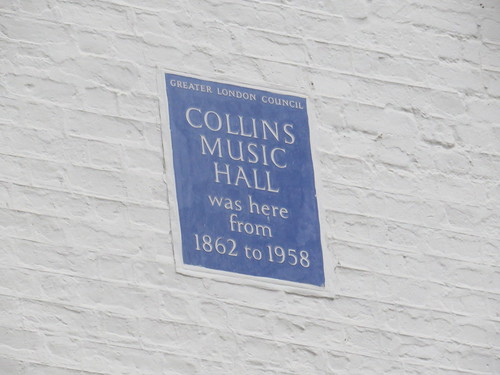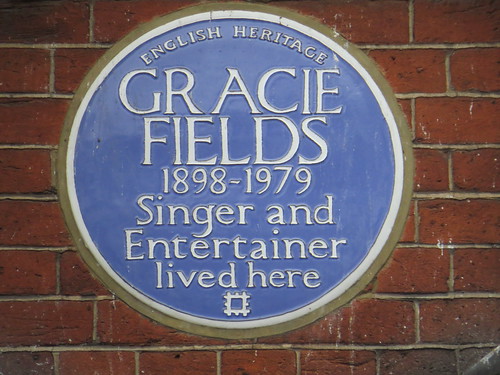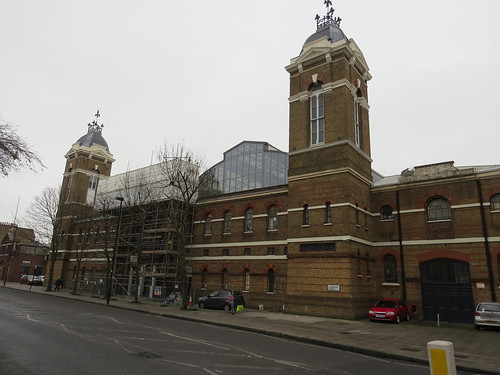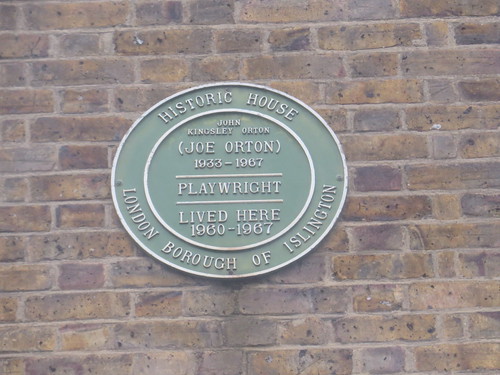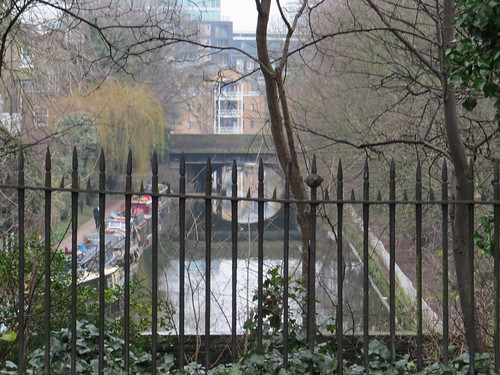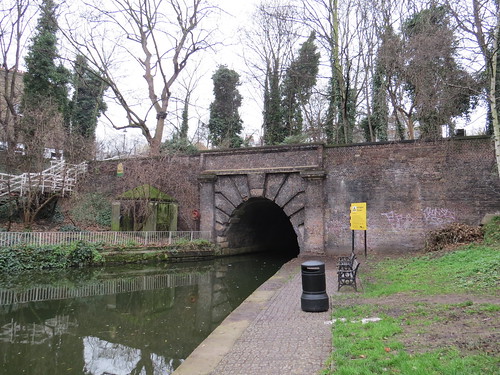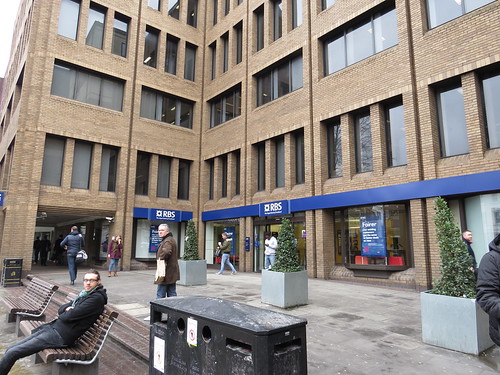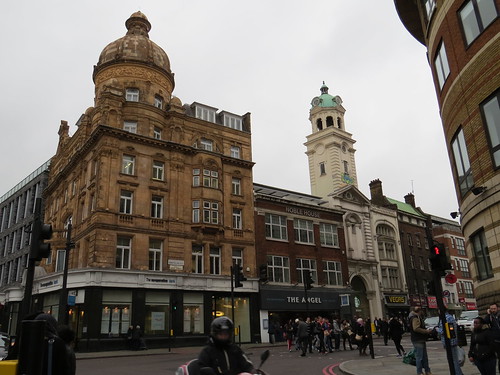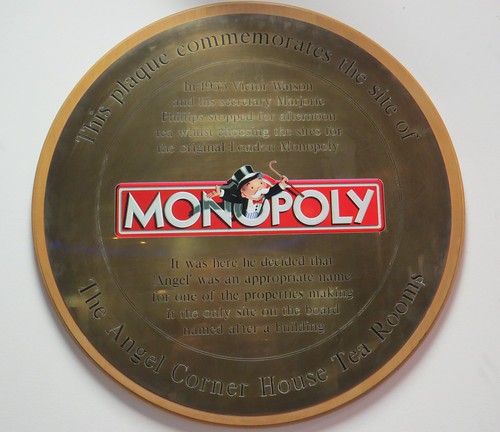N1 is another of those postcodes where there is so much potential that I will have to be selective. I must forgo King’s Cross and the amazing transformation which is happening there. Nor will I venture to trendy Hoxton (is it still trendy?). I will focus my attention on Angel.
Today this is a busy area with pubs and restaurants and a couple of cinemas and fringe theatres but as we shall see there has been much change here.
We start our walk at the main Post Office in Upper Street (numbers 160 -161). This is between Barnsbury Street and Waterloo Place. Turn right out of the Post Office and go along Upper Street. Our first stop is a little way on the right.
Stop 1: Number 147 Upper Street
Nothing much to see now but an Islington green plaque tells us this was the home of Victorian children’s illustrator Kate Greenaway (1846 – 1901) between 1852 and 1873
Kate Greenaway’s portrayal of children was very distinctive. She dressed them in her own versions of late eighteenth century and Regency fashions: smock-frocks for boys, high-waisted pinafores and dresses with mobcaps and straw bonnets for girls. Apparently Liberty of London adapted her drawings as designs for actual children’s clothes and it was all the rage amongst those who followed the Arts and Crafts movement to dress their daughters in Kate Greenaway pantaloons and bonnets in the 1880s and 1890s.
Apart from this particular vision of children, she is remembered though The Kate Greenaway Medal. This was established in 1955, for distinguished illustration in a book for children.
Continue walking along Upper Street, stopping at Number 127.
Stop 2: Number 127 Upper Street
This is now just an estate agents.
But this used to be a restaurant known as Granita. Legend has it that this was where Tony Blair and Gordon Brown agreed in the summer of 1994 on their approach to a future Labour government, following the death of Labour Party leader John Smith on 12 May that year.
It is said that Brown agreed that he would not challenge Blair in the election to become leader of the party. This gave Blair a clear run and allowed him to lead Labour into the 1997 general election (which Labour won). In return, it is said Brown would be granted wide powers over domestic policy in a Blair administration. Blair would stay in the job for an unspecified period. It is alleged he would then resign and support Brown to follow him as Leader of the Labour Party and Prime Minister.
The existence of any deal was denied for many years by both Blair and Brown. But the story has surfaced in a number of forms, not least in BBC journalist James Naughtie’s 2001 book “The Rivals: The Intimate Story of a Political Marriage” and a 2003 made-for-television film called “The Deal”, based in part upon Naughtie’s book.
Continue along Upper Street until you reach Islington Green where you turn left.
Stop 3: Number 10 Islington Green
This is site has had a long history of entertainment.
It started as a pub with a ‘saloon theatre’ in the 1790s. In the early 1860s, it was purchased by a man called Samuel Collins, who renamed it Collins’ Music Hall.
It was later rebuilt and enlarged, re-opening in December 1897 as Collins’ Theatre of Varieties. After a brief flirtation with programming films as part of the shows in the early 1900s, it settled down as a variety theatre under the name Collin’s Music Hall. It ran successfully until September 1958, when a fire destroyed Anderson’s Wood Merchants at the rear of the theatre, and did considerable damage to Collins’ Music Hall.
It stood empty and unused for several years. In April 1963, the remaining contents, fixtures and fittings were auctioned off and the remains of the building became a wood store for Anderson’s. This continued until around 2000 when the building was demolished, apart from the facade.
Today, the facade provides an entrance to a Waterstone’s bookstore. Housing was built on the site of the theatre and adjacent wood yard. There is a Blue Plaque on the facade marking the history of the theatre.
Return to Upper Street and ahead you will see our next stop.
Stop 4: Screen on the Green cinema (Number 83 Upper Street)
This is one of the oldest cinema building still in use in Britain.
The Empress Electric Theatre opened in October 1913. It was a simple building with a centrally placed entrance, with a paybox. There was no foyer – a pair of double doors led directly into the auditorium. The initial seating capacity was for 600 on a single floor. Shortly after opening it was renamed Empress Picture Theatre.
It was refurbished in 1951 and became known as the Rex Cinema. It was taken over by Screen Cinemas, who re-opened it in September 1970 as the Screen on the Green.
It was modernised in February 1981 and in particular it gained a foyer which the original building never had. This reduced the seating capacity to 300. The independent Screen Cinemas circuit continued to operate it until 2008, when the circuit was sold to the Everyman Media Group, who continue to run it. This cinema is now known as the Everyman Screen on the Green, although it is hard to see this on the outside signage, even when it is lit up.
In November 2010, the seating capacity was reduced from 300 to 120, with the installation of luxury armchair seats with footrests, individual cushions and lots of leg room, plus a licensed bar.
Here is a great little film from 2010 about being the film projectionist at the Screen on the Green, and doing it the old fashioned way.
http://www.npr.org/blogs/pictureshow/2010/10/04/130331693/projection
I was curious to find out whether this cinema had gone over to digital projection, so I popped in as I was passing. A nice young man who worked there said that at present they were using digital projection because there was a problem with the sound on their 35mm projection system. But once they got that fixed, they would use traditional projection when they could get films in 35 mm, as they regarded the old way as superior to digital projection.
Just by the by, the Caffe Nero here at Number 75 Upper Street was also an old cinema.
It was called the Electric Cinema but closed in 1916, and has been used as a shop in recent years. The full story at
http://cinematreasures.org/theaters/21252
But note how the world keeps changing in that we now have a coffee chain shop here whereas until fairly recently it was a branch of Blacks, the outdoor clothing people.
Keep walking along Upper Street.
Stop 5: Number 72a Upper Street
You may be wondering why we have stopped at this Tapas bar.
But look up and there is a blue plaque to none other than Gracie Fields (1898 – 1979).
Dame Gracie Fields was actually named Grace Stansfield. She was an English stage and screen performer who had huge success in the 1930s. Her most famous song was “Sally”. It became her theme song and was even worked into the title of her first film, Sally in Our Alley. This was a major box office hit in 1931.
She spent the later part of her life on the Island of Capri in Italy. She had been made a Commander of the Order of the British Empire (CBE) for “services to entertainment” in 1938, but just seven months before her death, she was invested as a Dame.
Now head towards the pointed end of the green (on the other side from the buildings in Upper Street) where you will see a statue.
Stop 6: Statue of Sir Hugh Myddleton
Sir Hugh Myddleton (1560 – 1631) was Welsh and turned his hand to many things: merchant, clothmaker, entrepreneur, mine-owner, goldsmith, banker and engineer. So why you may ask does he have a statue in Islington.
The reason his statue is here is because he was the driving force behind the construction of the nearby New River. This was an ambitious engineering project to bring clean water to London from the River Lea, near Ware, in Hertfordshire to a place just near Sadler’s Wells Theatre called the New River Head. Myddelton helped fund the project through to completion, obtaining the assistance of King James I. The New River officially opened on 29 September 1613 and was originally around 38 miles long. Parts of it are still in use today to supply water, although not at the southern end here in Islington.
Continue walking along Upper Street and stop at the break in the buildings.
Stop 7: Business Design Centre (formerly the Royal Agricultural Hall)
The Business Design Centre sets back from Upper Street. It has a modern front but behind is the Victorian Royal Agricultural Hall.
It is a Grade II listed building dating from 1862 and intended to be used agricultural shows. It was the home of the Royal Smithfield Club’s Smithfield Show from 1862 to 1938. There is even a plaque to remind of us of this, at the front.
It hosted the Royal Tournament from its inauguration in 1880 until the early 1900s when the event became too large for the venue and it moved to Olympia. It hosted the first Crufts dog show in 1891.
During the Second World War, the hall was commandeered by the Government, and from 1943, following the destruction of Mount Pleasant sorting office in an air raid, it became a Parcels Depot. After the war, the hall remained unused until it was converted to its present use of an exhibition hall, conference centre, showrooms and offices in 1986.
The new frontage is uninspiring. But you can get a glimpse of some of the old glass work from outside.
But if you want to get a better view of the hall go round to the Liverpool Road facade, where you see how grand it really is.
(to do this take the road to the left of the Hall, go left into Parkfield Street, then right into Bromfeld Street and right again into Liverpool Road)
Once though the the Agricultural Hall complex went right up to Upper Street. There was a structure here built in 1869, and originally intended to be used for the showing of pigs! It later became a concert hall known as St. Mary’s Hall. It began showing films in August 1900. From 1902 to 1908 it was a variety theatre known as the Empire Music Hall, but films were retained as part of the bill.
Then in 1908 it was a full time movie house known as the Palace Cinema. It was renamed the Blue Hall Cinema in 1918. Gaumont British Cinemas took over ownership in 1928, but the cinema kept its name until 1951 when it became the Gaumont.
It closed on 5th January 1963. The building was converted into a Top Rank Bingo Club which remained in operation until 1975. It was during this period that the building was Listed as Grade II.
Even though it was listed and presumably could have been used as part of a renovated Agricultural Hall complex, it was demolished in 1985 to make way for the opening which allowed sight of refurbished Agricultural Hall from Upper Street.
Now take the small side street (Charlton Place) across the main road and at the end of Charlton Place turn right.
Walk along Colebrooke Row which is to the left of the little garden, Duncan Terrace being to the right. Take the second turning on the left, which is Noel Road.
Stop 8: Number 25 Noel Road
And high up is an Islington Green Plaque.
I have to say I was not expecting to see this given this was where 1960s playwright Joe Orton was murdered by his partner. It just says he lived here and tactfully does also say he died here. Must be a little strange to live in a house which had such a high profile murder even though it is almost 50 years ago.
Return to Colebrooke Row and turn left.
Notice the green in the middle here. Until 1870 the New River ran through the middle of Colebrooke Row and Duncan Terrace in an open channel. It was then put into a pipe but in 1946 the water supply at the southern end of the New River was truncated at Stoke Newington. Not sure if the New River pipe is still under here somewhere.
And look down to your left. You can still see the Regent’s Canal as it pops into a tunnel which takes it under Colebrooke Row and then Upper Street and on towards the back of King’s Cross station.
The Regent’s Canal was constructed in tunnel which must have gone below the New River.
A sort of aquatic subway/flyover. And it is hard to believe you are just a stone’s throw from the hustle and bustle of Angel and it is strange to think that there is a canal running under the streets and buildings here.
Now go down Duncan Street (which is ahead of you if you stand with your back to the canal
Stop 9: Former tramway building
Our next stop is ahead just as you reach Upper Street
This building dates from 1906 and was built by the London County Council as an Electrical Transformer station for the local tramways. Angel was a major focus for the tram network in north London, as indeed it is today for buses.
Pevsner suggests that this building was inspired by Newgate Goal (demolished in 1902). It was repurposed as an antiques shopping arcade in 1979 and then more recently into a single shop, first Jack Wills and now Superdry.
The walkway to the right of the building is actually called Islington High Street and a few years back this and the adjoining (and confusingly named) Camden Passage was a major location for the antiques trade. There is still trading going on but it is a shadow of its former self.
Turn towards the tube station and look at the building to your left.
Stop 10: Number 40 Islington High Street
This may today be an uninspiring brick office block but for around 100 years this was a place of entertainment, first as a theatre and then a cinema.
Originally opened as a concert hall known as the Philharmonic Hall in 1860, it became the Philharmonic Theatre in 1874. It was destroyed by fire and re-built in 1883 to a design by renown architect Frank Matcham. This building was destroyed by fire and was rebuilt in 1888, again designed by Frank Matcham.
By now known as the Grand Theatre it was destroyed by fire and yet another theatre designed by Frank Matcham, opened here in January 1901 – this time known as the Islington Empire Theatre. The facade of the former Grand Theatre was retained in the rebuilding. The Empire Theatre mainly put on variety shows although there were some film sequences.
It became a full time cinema in March 1932. Although owned by Associated British Cinemas Ltd (ABC), it seems to have kept the Empire name. It suffered yet another fire in February 1938 but reopened the following February. It continued as a cinema on the ABC circuit until March 1962.
The auditorium was largely demolished and became a car park. The end came finally in 1981 when what was left of the facade was taken down. Apparently this went to the Museum of London for preservation, although I could not find it listed on their online catalogue. A bland office block for the Royal Bank of Scotland was built on the site.
You can go round the back (if you venture int Torrens Street which is EC1) and see what looks like the back wall of the old building. There was also a tank there when I visited!
Much more info and pictures at the wonderful Arthur Lloyd site:
http://www.arthurlloyd.co.uk/Philharmonic.htm
What a story and what a fated site!
Now look across the road from the station.
Stop 11: Number 7 Islington High Street
This look like it should have been a theatre or cinema building and indeed it was.
The Angel Picture Theatre opened on 19th March 1913. It had two separate entrances. This one on Islington High Street served the balcony, whilst the other entrance round the corner in White Lion Street served the stalls seating.
By 1929, the cinema was owned by Provincial Cinematograph Theatres who were a subsidiary of Gaumont British. It became the Angel cinema and seems to have kept this name until 1963 when it was renamed the Odeon (Gaumont having merged with Odeon to form the Rank Organisation)
The cinema closed in March 1972 and in 1974 the auditorium was demolished and offices built on the site. Amazingly the former balcony entrance with its tower feature survived but was bricked up for some 25 years. But it was refurbished and is now in use as a Starbucks coffee shop. This part of the former Angel Picture Theatre was designated a Grade II Listed building in 1991.
Now walk to the corner
Stop 12: “The Angel Building”
We cannot leave Angel without mentioning why this area is called Angel and the reason lies in what was once at the corner now occupied by the Co-operative bank.
This is the site of the Angel Inn which dated from the 16th century on lands belonging to the Clerkenwell Priory. It was rebuilt many times and it gave its name to Angel tube station, opened in 1901, and the surrounding Angel area of London. The present building in pale terracotta stone was completed in 1899. The pub ceased trading in 1921 and the building was sold to J. Lyons and Co.
It was adapted and reopened on 21 February 1922 as the Angel Cafe Restaurant. In 1959 it was acquired by the London County Council to make way for a new road scheme at the Angel intersection, which would have seen a roundabout like at Old Street station. Fortunately the plans were abandoned and the building was saved from demolition.
The building was renovated between 1979 and 1982, with a branch of the Co-operative bank on the ground floor and offices above.
Fascinating fact: You will probably know that “The Angel Islington” is a property in the British version of Monopoly where it is the third-cheapest property on the board (how times have changed!). Victor Watson, of John Waddington Ltd (who made the British version), and his secretary Marjorie Phillips stopped here for afternoon tea in 1935 when choosing London sites to be included. It was here that Watson decided to include Angel, even though it is not a street.
Go in the bank and you will find a plaque just inside the door on the right hand side which was put up in 2003. As the inscription notes Angel is the “only site on the board named after a building”.
Well that brings us to the end of our N1 walk. What I find fascinating is how much of the character has been lost in places like this. And I have not even mentioned all the pubs which have been lost, the ghostly reminders of which you see if you care to look.
We are just by Angel tube now for onward travel – and of course there are plenty of buses too.





